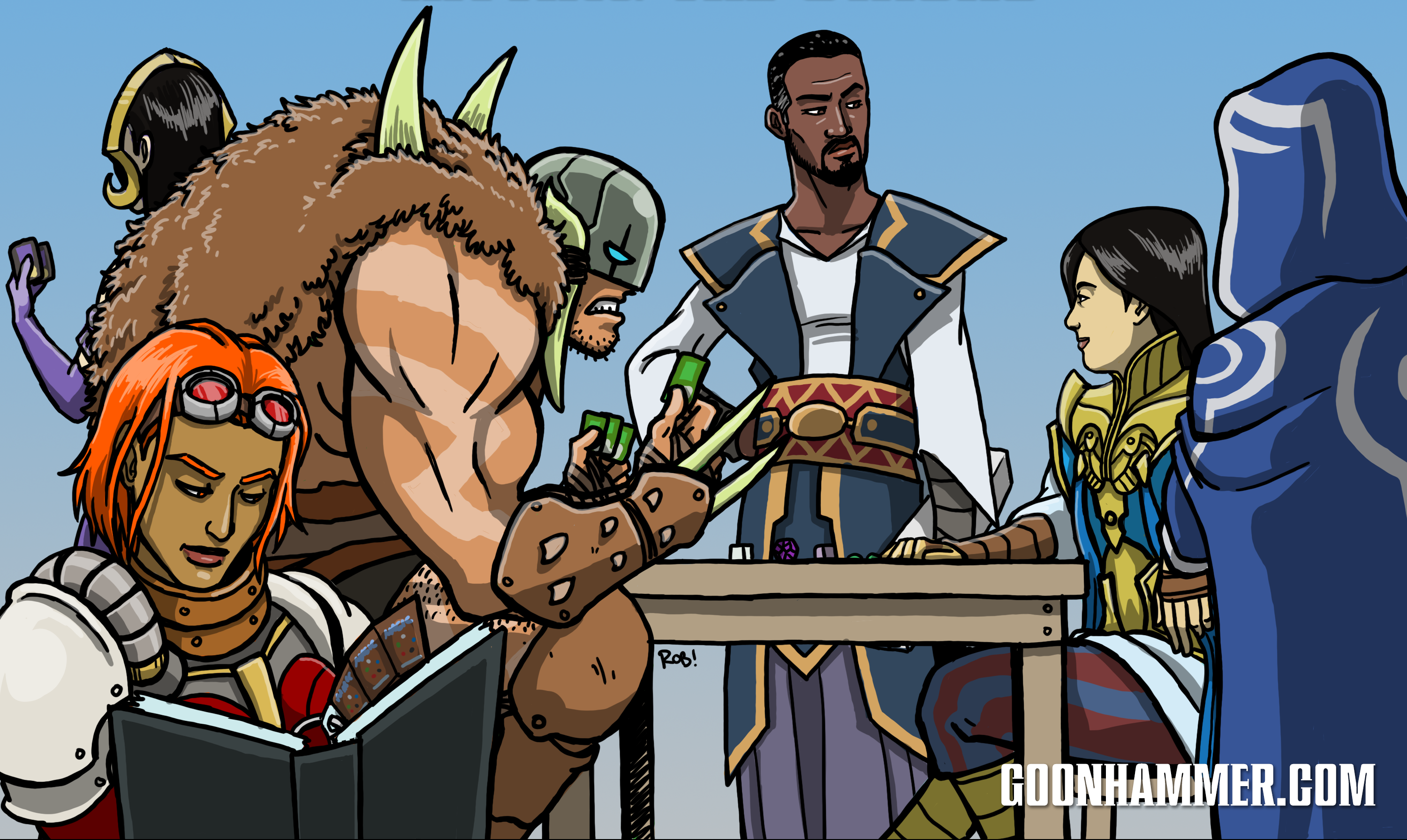
Hello there and welcome to the first in a series of new Magic: the Gathering Articles, focused on discussing various Deck Archetypes. As a bit of an intro, my name’s Marcy, and I usually write about board games here on Goonhammer, but I’m actually a MTG goblin in secret, having been playing the game for 30 years on and off, mostly in Standard and other competitive formats (Modern and Legacy). These days, I mostly grind the Mythic rank of Arena, dabbling in Modern and Explorer when I’m feeling extra spicy. As such, my focus in the game is a little different than some of the other things we’ve covered so far on here, and I thought to myself: “Self, wouldn’t it be cool to tell readers curious about different types of deck styles how they work, where to start, or what makes those decks so much fun to play?!” And I said, “Yes, of course, Queen Marcy, you’re so smart and creative!” So here we are: Arche-typos, with our first installment, focusing on my favorite style of deck: Reanimator!
Reanimator is a fun and flavorful deck that has one goal: cheat in huge, game breaking permanents from the Graveyard to the field quickly and take over the game before your opponent can easily respond. Let’s take a look at how Reanimator works in theory, the types of cards you’re looking to play, and then give you some sample decks for Standard and Explorer that you can consider trying yourself!
Don’t Expect it to Tango: Making the Dead Dance Again

Reanimator decks are one of the most stalwart types of Magic deck archetypes, dating back to Alpha and Beta days with the card Animate Dead. Of course, the card back then was a semi-confusing mess of rules, essentially attaching an Aura Enchantment to a card in a graveyard, but it had an amazing upside: it allowed the owner of the enchantment to select ANY creature from ANY graveyard, meaning that what’s yours is also mine! Since then, there have been a vast array of similar cards, such as the aptly named Reanimate, Exhume, Unburial Rites, Goryo’s Vengeance, and Stitch Together being some of the most famous. Reanimator style decks also tend to face criticism for being “unfair”, because the monsters being cheated into play with the cards are vastly outclassed for the cost of doing so; Animate Dead has a Converted Mana Value of 2, and most Reanimator style cards are very similar, floating between 3-4 CMV historically. To combat this, many of them have some sort of downside – Animate Dead gave the monster -1/0, Exhume allowed both players to reanimate a target in their graveyards, Stitch Together required payment of life – but the downside was never really enough to deal with pulling things like Griselbrand, Elesh Norn, Grand Cenobite, Sun Titan, and the like out of a graveyard for “free”.
That’s the part of Reanimator that makes things fun: you aren’t simply getting monsters from your Graveyard and putting them into play, you are usually wanting to target huge, game altering monsters (literally and figuratively) that easily take over the game state, placing your opponent on a usually insurmountable backfoot. There are few decks that, at the 2-3 mana threshold, can deal with an Elesh Norn being windmill slammed onto the field, and even if they can destroy the card, well… the deck type IS called ‘Reanimator’, after all! Even with how much slower Standard has gotten with recent sets, Reanimator style decks can still accomplish the same goal of hurling big problems into your opponent’s way well before they can comfortably deal with them.
But how do we GET monsters into the Graveyard? Well, that comes with the real strategy of Reanimator decks: knowing how to self-mill and discard smartly, and at the right time. Many decks, especially many current Standard decks, run a lot of Exile and Graveyard hating cards (such as Graveyard Trespasser, the little jerk), meaning that it isn’t enough to stack your Graveyard, but to do so RIGHT. For this, most Reanimator decks run a variety of colors, historically a combination of White, Black, and Red, as many Red “Draw X” cards come with a rider that makes you discard cards. One of the most famous of these cards, Faithless Looting, reads: “Draw two cards, then discard two cards.” At 1 Red mana, Faithless Looting remains a staple in quite a lot of decks, and is banned in Modern literally because it fueled so many Graveyard style decks. Splashing colors isn’t unheard of in Reanimator style play, because if things go really sideways, you need to be able to cast the creatures from your hand, but if you reached that point of the game, it’s probably not looking too good!
Pet Cemetery: Cultivating Your Graveyard
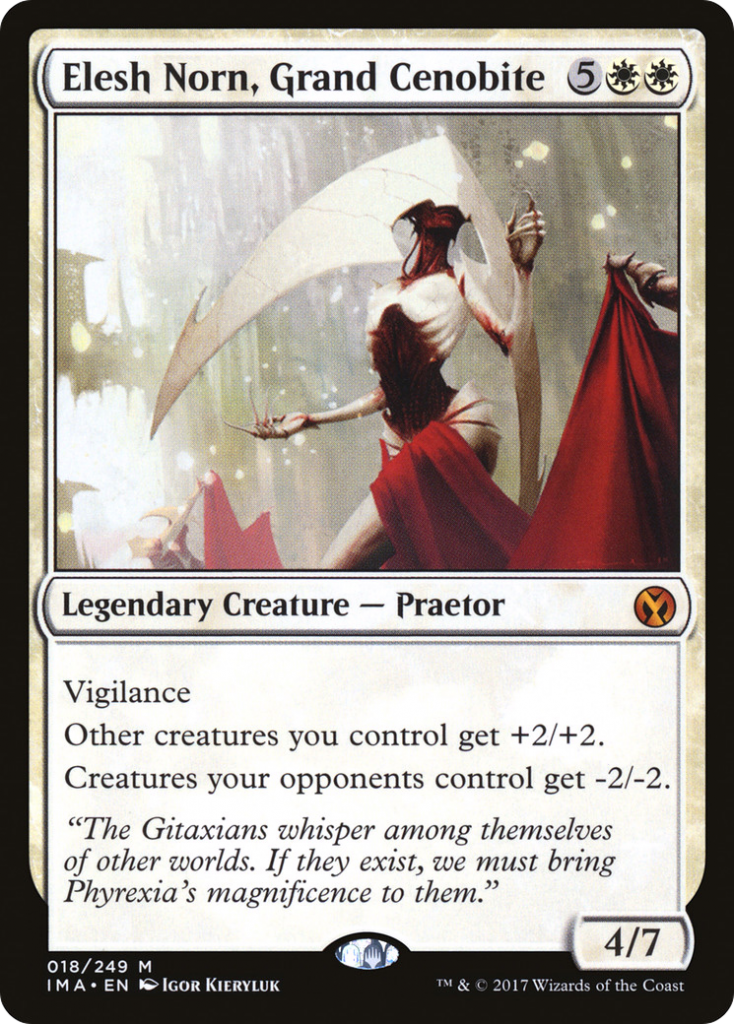
Assembling the right collection of creatures for a Reanimator deck requires fairly good knowledge of the current meta you’re playing in, but it also requires some knowledge of what it means when your creature does hit the board. While it might seem enticing to simply cheat in big, huge power and toughness creatures, Reanimator decks don’t win by just turning cards sideways (usually): they win by bringing in back-breaking cards that do many things upon their Enter the Battlefield effects. This is very important, because again, you are *not casting these cards*, meaning that creatures that say “When you cast” are not what you’re looking for in these styles of decks.
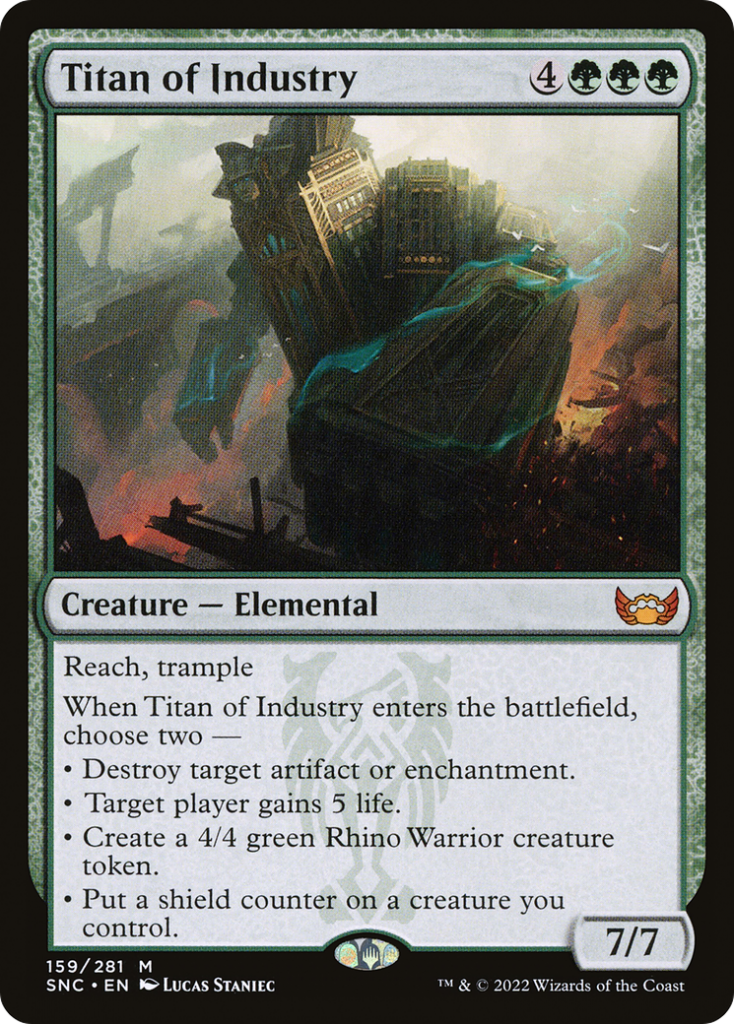
Perhaps the best current example of this card is Titan of Industry from New Capenna, which, spoiler alert, is one of the most bonkers reanimator style cards possibly ever. A 7/7 Reach, Trample creature for 7 mana, Titan of Industry would already be a solid body on the field, but when Titan of Industry enters the battlefield, you get to select *two* of *four* absolutely insane options:
- Destroy target artifact or enchantment.
- Target player gains 5 life.
- Create a 4/4 green Rhino Warrior creature token.
- Put a shield counter on a creature you control.
When lined up with all of the things it does, 7 mana seems “fair”, but… well, we are talking reanimator. We don’t do fair. We want to get this thing onto the battlefield as early as we can, and most opponents are going to have a hard time dealing with a card that does so many things at once. Red Deck Wins style aggro beating you in the face with small creatures? Well, a 7/7 body that brings a 4/4 buddy and gives you 5 life back is usually enough to make RDW player scoop up their cards. Enchantment or artifact heavy engines running wild on the field? Well, just have your Titan explode them. Tons of spot removal? Making a body and giving a creature a shield token means that it will require more work than normal to get rid of things.
You get the picture; most Reanimator targets do things similar to Titan of Industry: they take over the game. The “classic” Titans, such as Sun Titan, Grave Titan, and Inferno Titan similarly were common targets for this style of deck, but other big “bombs” can fill out a deck nicely. Classic cards such as Massacre Wurm (creatures your opponents control get -2/-2 until end of turn, and then opponents lose 2 life per creature that dies) or Elesh Norn, Grand Cenobite (creatures you control get +2/+2, creatures opponents control get -2/-2) often destroy aggressive decks, especially if brought into play earlier than normally expected. Other cards, such as Sheoldred, Whispering One, can be great for the fact that they continually mess with opponents: old Sheoldred allowed you to return a creature card from your graveyard at the start of your turn, meaning that reanimating her likely nets you free continual reanimation while she’s on the field, and ALSO makes your opponents sacrifice a creature during their upkeep, getting around hexproof, indestructible, or other removal resistant barriers.
So, when looking to play Reanimator, you want to know not just HOW you’ll get the cards onto the field and how to get them into your Graveyard, but also WHO you want to be looking to reanimate. Sadly, Reanimator can’t make ‘big’ creatures good just because they hit the field early. You want to focus on big, impactful creatures that really shake up the board state upon entering the field, and who can continue to disrupt the game as long as they are on the field (or, possibly, by coming back from your Graveyard again, and again, and again…)
Protecting Yourself from an Early Grave, and Knowing Your Match-ups
Reanimator decks also dip into forms of spot removal. Sometimes, you don’t get the looting effect you need early, or your opponent presents a type of threat that you need to take care of before things get out of hand; even Titan of Industry can’t solve EVERY problem. For this reason, after your four of reanimation spells and reanimation targets, a reanimator deck usually runs a utilitarian set of spot removal cards. This is helped by the common colors of Reanimator: White has lots of Exile permanent instants that cost 1 or 2 CMC, Black is the Queen of cheap removal, and Red can have surprising versatility early game; current Standard legal card Cathartic Pyre, for example, serves as either spot removal in the form of 3 damage at instant speed, OR a draw 2, discard two engine.
Of course, every deck can’t win all the time. Very aggressive decks will sometimes manage to steamroll you before you can get your engine going, especially if they are on the play. Control decks can also be a problem, as one of the best ways to disrupt control, forcing them to play cards on their turn, is hard for Reanimator decks to do, meaning that sometimes it becomes a waiting game of baiting your control playing opponent into taking action before you do, but even that might be difficult as many control decks forms of removal do so by Exile, not destroying things.
Still, Reanimator is a very strong Archetype. It plays a somewhat different game of Magic than other types of decks do, and can be a fun deck to play if you’re looking to get some mileage out of big, powerful cards but aren’t sure how to cast or utilize them to great effect. Also, by directly interacting with the Graveyard, it also can be a great style of deck to make yourself more familiar with the intricacies of Magic that go beyond simply “draw card, play card” style of play. So, ready to get digging? Well…
Brother’s War Standard Reanimator
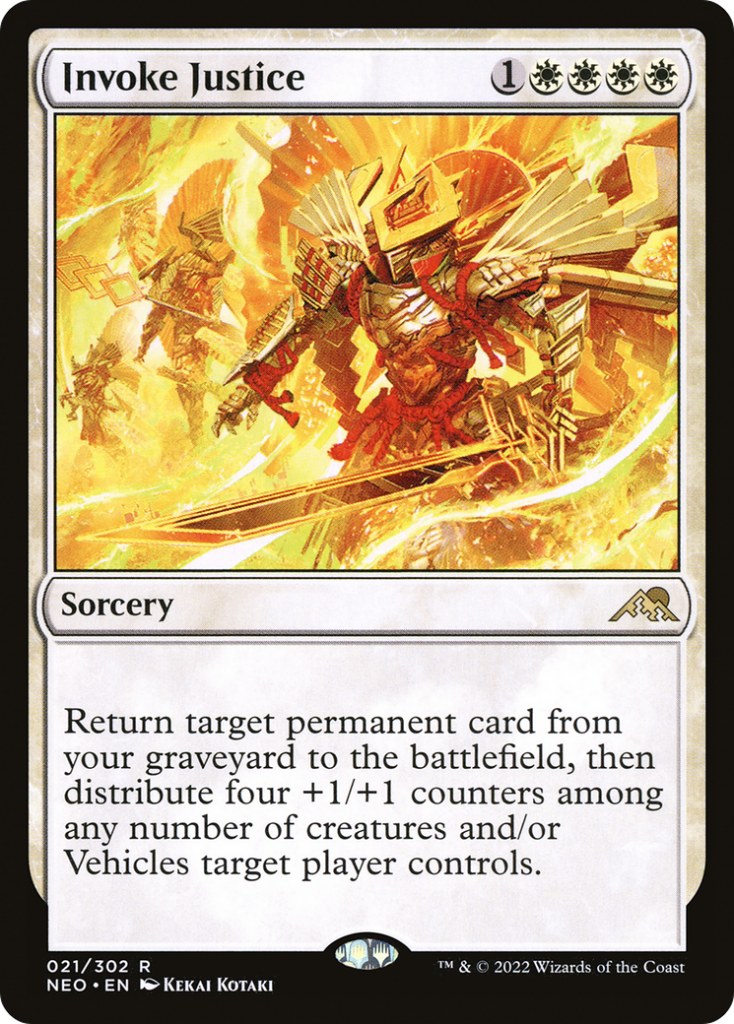
If you are enticed to engage in some necromancy, you’ve picked a great time to do so. Currently, Brother’s War Standard features numerous “Reanimate” style cards, spread between White, Black, and Colorless predominantly. And, perhaps to no surprise, most styles of Reanimator decks currently circling around in Standard circles involve Titan of Industry, and it isn’t even a close second place for other targets, such as Sanctuary Warden, but they are also very good targets).
Perhaps the best overall Reanimation spell in Standard is also somewhat awkward to cast: Invoke Justice, a 5 CMC spell that require *four* White and 1 colorless, returns a permanent from your graveyard and also allows you to distribute 4 +1/+1 tokens. The CMC on Invoke Justice is wonky, and perhaps one of the most unfriendly Reanimator style spells out there, but there are still sneaky ways to get this spell to fire off on turn 4 if paired with Fable of the Mirror-Breaker‘s treasure making goblin token. And, with how BRO Standard is, Turn 5 isn’t always ‘too late’ to simply cast a spell. The nice thing about Invoke Justice is that it targets *any* permanent, which brings us to the newest Reanimator card, Portal to Phyrexia.
At *9* colorless mana, Portal is an extremely expensive card, and for good reason. When it enters the battlefield, it forces opponents to sacrifice three creatures. And then, on your upkeep, you are able to return ANY creature from ANY graveyard to the battlefield. While it doesn’t give you instant reanimation, the board wipe potential paired with recurring reanimation makes Portal a very attractive target for Invoke Justice, or the similarly 5 CMC spell Repair and Recharge, which reanimates everything BUT creatures.

In Black, Sheoldred’s Restoration is much more in line with older types of reanimator cards, having the pay life requirement of Stitch Together, but also a much larger CMV that makes it slightly less palatable; paying 4 mana AND probably 7 life (although, for a Titan of Industry, you get 5 back if you want!) is sometimes rough. However, Sheoldred’s Restoration has a nice kicker for 3 CMV (2 colorless and a white) where you GAIN life instead of lose life. Seven mana is a lot to reanimate with, but paying 7 to gain life AND return a bomb to the field can sometimes be the thing you needed to secure a final win.
Lastly, Cruelty of Gix returns to the realm of enchantments, offering a Level 3 option to return any creature card from any Graveyard to the Battlefield under your control. You can even opt to simply skip right to that step, although the first 2 steps are quite good also, but it makes Cruelty a somewhat flexible card to use for reanimation.
Here’s an example decklist that I’m currently playing around with in Standard:
This deck has a lot of the hallmarks of classic Reanimator, but only 6 total targets: 2 Sanctuary Wardens and 4 Titans of Industry. However, you’ll often find opponents will just give up the moment a Titan hits the field, and many give up if TWO hit the field back to back. The rest of the cards here are mostly ‘Good Stuff’ mixed with various helpful ways to win. Wandering Emperor can be a secondary win-con, a good target for reanimation, and spot removal for threats. Chaotic Transformation is a secondary way to get things onto the field, working more like a Polymorph effect (always, ALWAYS make sure you have an artifact available to transform). Fable and Restoration of Eiganjo are good ramp, and the rest of the cards serve as spot removal. You can certainly play around with this list and sub in things you have or don’t have, such as The Elder Dragon War instead of an Urza’s Sylex or Brotherhood’s End, but otherwise this is the ‘shell’ you’ll want to play with for Standard Reanimator.
Explorer Greasefang
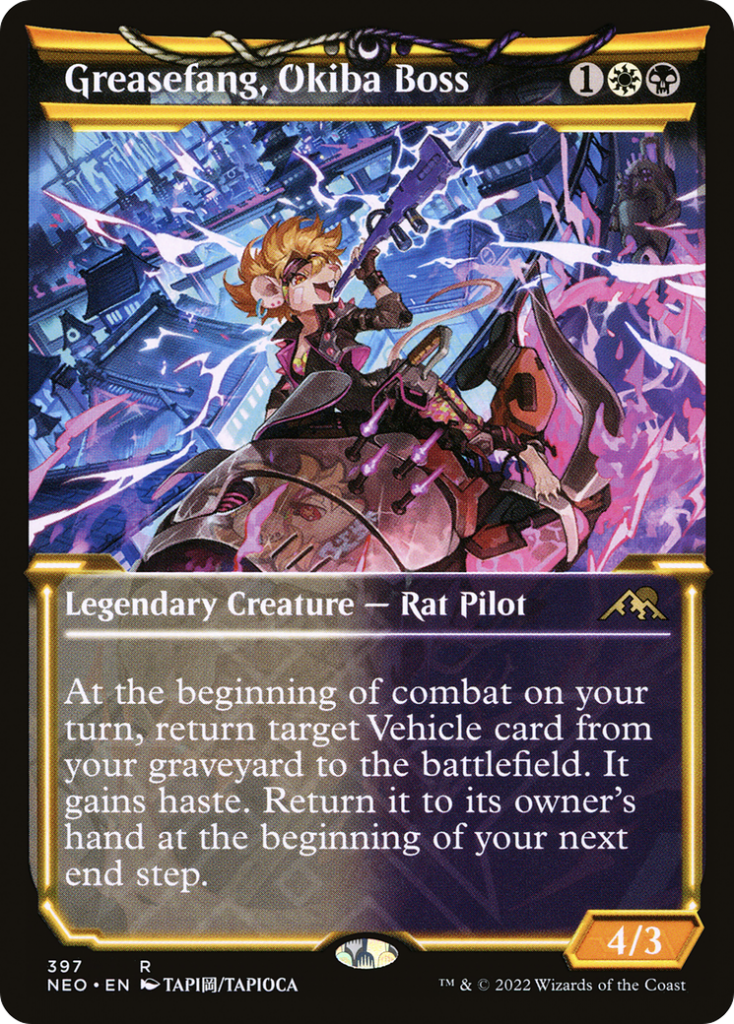
And now, ugh… Well, look. Reanimator decks aren’t *fair*, but Explorer has one very specific Reanimator deck that is VERY not fair when it works. We’re talking “You win turn 3” unfair, and that card is Greasefang, Okiba Boss. Unlike most Reanimation spells, Greasefang isn’t a sorcery, meaning that she can die to spot removal before triggering her ability, but this is why Greasefang decks run Duress and Thoughtseize, as well as Can’t Stay Away, to get around that problem.
If I seem reluctant to mention this deck, it’s actually because I don’t quite find it as fun as other Reanimator shells. It’s very strong and there are multiple types (I like using Stitcher’s Supplier, for example, but others don’t), but you don’t quite get the ‘oomph’ of other reanimation style decks. As for why Greasefang isn’t popular in Standard, well, she dies to a LOT of things, and BRO Standard is filled with very easy, very cheap removal that many other formats don’t often run as plentifully, but the reality is that there aren’t a ton of viable good Vehicles for her to reanimate. In Explorer, though, she has access to Esika’s Chariot, Parhelion II, and Skysovereign, Consul Flagship, all three of which are easily able to ruin your opponent’s day immediately.
If you’d like to get down with the ratgirl biker boss, you can take a look at the deck I use here:
Please note that you may lose friends and make enemies playing Greasefang, and that the deck isn’t dominating; in fact, neither is the BRO Reanimator I gave you, but at least I find that one more fun and interactive! Your mileage may vary.
Corpse-a-Corps
And with that, the first installment of Arche-typos comes to a close. I hope, if you’re new to Magic, this gives you some ideas of a deck type you’ve never played before, and I urge you to expand your horizons and play various archetypes. They’re great ways to get to know Magic better, and can really spice up the doldrums of Standard or otherwise. You can obviously take some of this information with you into formats like Commander, as well, but just remember that Reanimator benefits from having multiple opportunities and targets, so Commander based Reanimator tends to work a little differently based on the singleton nature of the format.
Either way, I hope you enjoyed learning about Reanimator! Now, if you don’t mind, I seem to have misplaced the brain I wanted to use… this one says… “Abby Normal”…? Make sure to keep an eye out for the other decks in the series! If you have any questions or feedback, drop us a note in the comments below or email us at contact@goonhammer.com.
